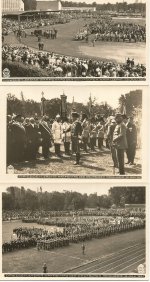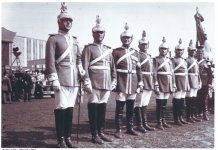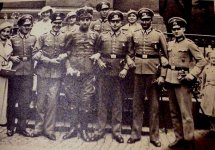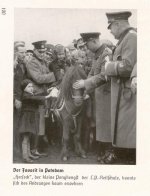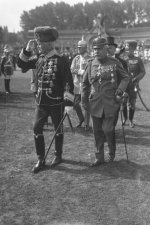You are using an out of date browser. It may not display this or other websites correctly.
You should upgrade or use an alternative browser.
You should upgrade or use an alternative browser.
1931 in Germany
- Thread starter KAGGR#1
- Start date
ww1czechlegion
Well-known member
Excellent photos Steve, thanks for posting them. 
Naprawiacz
Well-known member
He belonged to the right-wing paramilitary organization "Stahlhelm." As a result, he became a supporter of the Nazi party and Adolf Hitler's policies. Some believe that his support for the Nazis defiled his reputation, but his belief in the power of the German people and his desire to resume conscription were supported not only by him, but also by many other former senior officers of the Imperial Army. In 1934, after Hindenburg's death, Mackensen was the only living retired Field Marshal of the German army. In 1935, due to his long service in the Prussian cavalry, he was appointed honorary commander and patron of the 5th Pomeranian Blücher Hussar Regiment, which continued the tradition of the famous "Black Hussars." The regiment was stationed in Pomerania in Stolp (Slupsk). In 1938. "long-lived" Mackensen, began to be more critical of the Nazi regime, when top commanders in the armed forces were removed from their positions. His protests and interventions went unheeded and proved ineffective.
In the link is a video from my city
In the link is a video from my city
SCHUPO
Well-known member
From a photo album in my collection. Be aware that the nationalized Polizei officially inherited the flags and traditions of many of these Imperial units after 1933. This was particularly noticeable in the Colonial units including the Polizeitruppe. Notice the mix of soldiers in this group photograph.
Also, notice the Southern Cross shield on the left arm of Landespolizei General Wecke from this Police Day (Tag der Deutschen Polizei} book. The little Police horse's name was Herseck.
Also, notice the Southern Cross shield on the left arm of Landespolizei General Wecke from this Police Day (Tag der Deutschen Polizei} book. The little Police horse's name was Herseck.
Attachments
KAGGR#1
Well-known member
It looks like they were making a film of the eventI wonder if the uniforms and helmets worn in these photos
were from pre WWI or ones they purchased in the 20's or 30's ?
Note the Saxon Garde Reiter Regt
Do other members have photos from this event ?
SteveView attachment 29957View attachment 29958
Steve
The Waffentag der Deutschen Kavallerie or German cavalry arm of service day of 1931 was the first of a series of annual commemoration reunions/parades organized by the German cavalry association (Waffenring) culminating in the 8th at Erfurt in 1938. The patron was none other than Generalfeldmarschall von Mackensen himself. He was accompanied in the Dresden parades and seen in profile in Steve's 2nd image by the Saxon Generalleutnant a.D. Otto von der Decken, a former wartime cavalry division commander.
Regards
Glenn
Regards
Glenn
These are from the Bundesarchiv and show the same day in 1931.
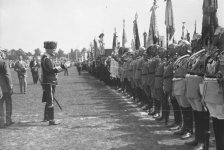
The original caption to the above image "Generalfeldmarschall von Mackensen inspects the front of the Garde-Kürassier-Regiment on the Ilgenkampfbahn (a stadium) in Dresden).
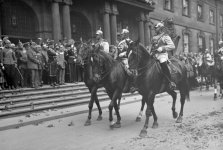
March past of the old German cavalry before Generalfeldmarschall von Mackensen on the steps of the Dresden town hall.
Regards
Glenn

The original caption to the above image "Generalfeldmarschall von Mackensen inspects the front of the Garde-Kürassier-Regiment on the Ilgenkampfbahn (a stadium) in Dresden).

March past of the old German cavalry before Generalfeldmarschall von Mackensen on the steps of the Dresden town hall.
Regards
Glenn
JzPf
Well-known member
Great photo showing a nice mix of veteran’s cavalry units with their verein standards, including four Jäger zu Pferde NCO’s.These are from the Bundesarchiv and show the same day in 1931.
View attachment 30009
The original caption to the above image "Generalfeldmarschall von Mackensen inspects the front of the Garde-Kürassier-Regiment on the Ilgenkampfbahn (a stadium) in Dresden).
View attachment 30010
March past of the old German cavalry before Generalfeldmarschall von Mackensen on the steps of the Dresden town hall.
Regards
Glenn
KAGGR#1
Well-known member
GlennThe Waffentag der Deutschen Kavallerie or German cavalry arm of service day of 1931 was the first of a series of annual commemoration reunions/parades organized by the German cavalry association (Waffenring) culminating in the 8th at Erfurt in 1938. The patron was none other than Generalfeldmarschall von Mackensen himself. He was accompanied in the Dresden parades and seen in profile in Steve's 2nd image by the Saxon Generalleutnant a.D. Otto von der Decken, a former wartime cavalry division commander.
Regards
Glenn
As always great information
Thank you
Steve
KAGGR#1
Well-known member
GlennThese are from the Bundesarchiv and show the same day in 1931.
View attachment 30009
The original caption to the above image "Generalfeldmarschall von Mackensen inspects the front of the Garde-Kürassier-Regiment on the Ilgenkampfbahn (a stadium) in Dresden).
View attachment 30010
March past of the old German cavalry before Generalfeldmarschall von Mackensen on the steps of the Dresden town hall.
Regards
Glenn
Great photos
and thanks so much for adding them.
Steve
KAGGR#1
Well-known member
GlennAnother one from the Bundesarchiv. This gives a good view of General von der Decken. I am speculating that the Garde-Reiter-Regiment officer is Oberstleutnant a.D. Edzard Freiherr von Hake who was the chairman of the Saxon branch of the German cavalry association/union.
Regards
Glenn
View attachment 30036
Another great photo !
Many thanks for the post
Steve
KAGGR#1
Well-known member
By the way the shoulder straps of Generalfeldmarschall von Mackensen for the 1 L H R 1Another one from the Bundesarchiv. This gives a good view of General von der Decken. I am speculating that the Garde-Reiter-Regiment officer is Oberstleutnant a.D. Edzard Freiherr von Hake who was the chairman of the Saxon branch of the German cavalry association/union.
Regards
Glenn
View attachment 30036
are shown in Mike Kelso's book . They are in a private collection .
Steve

